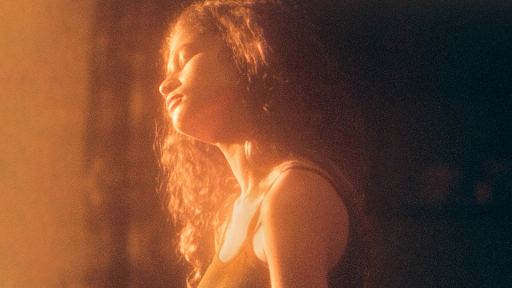Media and Music: "Euphoria" Adopts Retro, Era-Defying Soundtrack in its Second Season
After attracting worldwide acclaim for its whimsical score, “Euphoria”’s music continues to dazzle audiences in its second season, this time with more throwback hits and retro sounds.
In Media and Music, our writers take a deep dive into how movies use scores and songs to engage viewers, give new meaning and tone to some of our favorite scenes, and establish themes. It almost goes without saying, but there are spoilers abound.
Written by Sage Dunlap
Images courtesy of HBO
With closed eyes, a sunlit Zendaya basks in a warm bronze glow in the poster for the second season of “Euphoria.” Beautifully contrasting with the glittery, cool-toned poster of the series’s first season, the images seem to indicate a shift in the stylistic tone of the beloved HBO drama — an embrace of more retro aesthetics. Though this change is apparent in the season’s warm color palette and toned-down makeup looks, one aspect of the show most directly reflects an embrace of the past — its music.
“Euphoria” became an instant hit following its 2019 debut for its signature technicolor aesthetic and over-the-top costume design abiding by no school dress code, and the show’s soundtrack — produced largely by London-based artist Labrinth — garnered the attention of critics around the globe. “In a show brimming with thematic material, Labrinth’s voice really does become an unseen ethereal thread connecting all of the central figures in ‘Euphoria,’” Indiewire critic Steve Green said. In 2020, the musician even earned the series an Emmy for Outstanding Original Music and Lyrics with the work he’d done on the show.
The airy, largely electronic score of Euphoria’s first season constructed a dynamic universe, giving the series a very signature sound. However, the soundtrack of season two focuses on incorporating timeless gems into the show’s storyline — a wise stylistic choice from the showrunners. In the season premiere, a high school New Year’s Eve party recalls multiple ‘90s hip-hop tunes, from DMX’s “Party Up” to Juvenile’s classic Lil Wayne and Mannie Fresh collaboration “Back that Azz Up.” In episode four, 43-year-old Cal Jacobs and 18-year-old Cassie Howard both drunkenly perform a sloppy, emotional rendition of Sinead O’Connor’s 1983 hit “Drink Before The War” in separate locations — a parallel reflecting the era-defying nature of this season’s soundtrack. As the wistful track plays, Cal poignantly slow dances with a stranger, while Howard contrastingly belts each lyric in between swings of champagne and entangles herself into an arrangement of party balloons.
Season two also contains many nods to INXS. In a flashback sequence opening episode three, Cal Jacobs — a character grappling with a turbulent past — is shown driving to a cassette of “Mystify” and later dancing to “Never Tear Us Apart” with his best friend in a hazy, bittersweet bar scene set in the ‘80s. In the present, many INXS hits, such as “Devil Inside” and “New Sensation,” accompany scenes involving Cal, illustrating how music connects the troubled character to his past.
The season’s seventh episode showcased a much anticipated and wildly expensive high school production written and directed by beloved underdog Lexi Howard that had audience members on and off screen clutching their seats. Two dance numbers included songs from way before Lexi’s time at East Highland High School — the first being a provocative cheer routine choreographed to early 2000s R&B song “Oops (Oh My)” by Tweet and Missy Elliot. The second musical number perhaps stole the show, having fans frantically posting to Twitter to revel in its extravagance. A herd of male dancers in skin-tight gold unitards took the stage and executed a raunchy, Jazzercise-inspired routine to the 1984 hit “Holding Out for a Hero,” famously sung by Bonnie Tyler for the film “Footloose.”
Described by cast member Javon Walton as shocking and extremely devastating, the season finale underscored both resolutions and tragedies with dynamic orchestral arrangements reminiscent of a melodramatic opera. Among grand instrumentals from composers like Ennio Morricone and Francis Lai, early 2000s diva anthems still made the cut, with a newly liberated Cal Jacobs blasting Kylie Minogue’s “Can’t Get You Out Of My Head” in a seedy warehouse among the new friends he made after his abrupt departure from the Jacobs’s house.
By incorporating throwbacks in the show’s tracklist, the theme of characters revisiting old wounds is reinforced. Whether reeling from an abusive relationship or working through substance abuse, every major character in the show is affected by past trauma. “Euphoria” encourages audiences to analyze how a harmful past can damage a person and affect their actions. Relying heavily on flashback scenes and focusing on the concept of “the past,” a nostalgic soundtrack full of 90s R&B and 80s rock is the perfect fit for the show’s second season.


